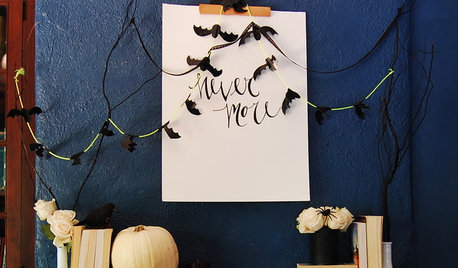Lordy, What is This?
sneezer2
10 years ago
Related Stories

ARTThe Beauty of Bonsai — Living Art, Rooted in Harmony
Create your own emblem of nature's balance with an art form dating back 1,000 years
Full Story
HALLOWEENEasy Halloween Decorations From Stuff You Already Have
Go spooky or sophisticated with these DIY mantel decorations made from household items
Full Story
LIVING ROOMSRoom of the Day: High Eclectic Style in a Luxe Sitting Room
Rich textures and contemporary art make this swank sitting room both restful and invigorating
Full Story
HOUZZ TOURSHouzz Tour: Playful Luxury Infuses a 1929 Houston House
Understated elegance gets an update with thoughtful splashes of color, pattern and glamour in a gracious Texas family home
Full Story
GARDENING AND LANDSCAPINGRenovation Detail: The Blue Porch Ceiling
Ghostly legends spurred the Haint Blue porch ceiling trend in the South, but you can pick this color just because it's pretty
Full Story
FARM YOUR YARDIf You Have Room for Only One Summer Crop ...
Get an edible that’s long on flavor even if you’re short on space, with a long-time gardener’s favorite picks
Full Story
HOUZZ TOURSMy Houzz: 2 Tools + 1 Resourceful Guy = Lots of Great ‘New’ Furniture
With scrap wood and a hands-on attitude, a San Francisco renter on a tight budget furnishes his bedroom and more
Full Story
FUN HOUZZDon’t Be a Stickybeak — and Other Home-Related Lingo From Abroad
Need to hire a contractor or buy a certain piece of furniture in the U.K. or Australia? Keep this guide at hand
Full Story
GARDENING GUIDESBackyard Birds: Healthy Home Habitats for Northern Flickers
These colorful woodpeckers found across the U.S. and Canada love berries, seeds and ants and often nest in deep burrows in trees
Full Story
DECORATING GUIDESHow to Make Your Home Feel More Like You
Show your real style through a favorite color, everyday accessories, art, collections and more
Full StorySponsored
More Discussions






sneezer2Original Author
digdirt2
Related Professionals
Fort Lee Landscape Architects & Landscape Designers · Harvey Landscape Contractors · Hawaii Landscape Contractors · Marlborough Landscape Contractors · Rockwall Landscape Contractors · Smyrna Landscape Contractors · Catonsville General Contractors · Ewing General Contractors · Irving General Contractors · Marietta General Contractors · McPherson General Contractors · Parsons General Contractors · Port Saint Lucie General Contractors · Avocado Heights General Contractors · Urbana Decks, Patios & Outdoor Enclosuressneezer2Original Author
sneezer2Original Author
digdirt2
sneezer2Original Author
digdirt2
jean001a
seysonn
sneezer2Original Author
sneezer2Original Author